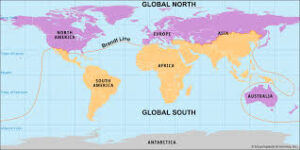The Global South refers to developing, less industrialised, and low-to-middle income nations, largely situated in Asia, Africa, Latin America, Oceania, and the Caribbean.
It contrasts with the Global North, which includes wealthier, industrialised nations of North America, Europe, Japan, South Korea, Australia, etc.
The term emphasizes geopolitical, economic, and developmental inequalities, not just geography.

Origin of the Concept
- Initially used during the Cold War to distinguish between industrialised and developing nations.
- Emerged as a replacement for terms like “Third World” or “Developing World”, which carried colonial/pejorative undertones.
- Gained traction in academic and diplomatic discourse after the 1980s.
Characteristics of Global South
- Economic Features:
- Relatively low per capita income.
- High dependence on agriculture, natural resources, and low-value exports.
- Greater vulnerability to external shocks (oil price, global financial crises, climate change).
- Demographic Features:
- Large and growing populations.
- Youth-dominant demographics, creating both an opportunity (demographic dividend) and challenge (employment generation).
- Political Features:
- Colonial history and struggles against imperialism.
- Often weaker global bargaining power in institutions like WTO, IMF, World Bank, UNSC.
- Social Features:
- Issues like poverty, inequality, malnutrition, inadequate healthcare, and education gaps.
Importance of the Global South
- Represents ~85% of the world’s population.
- Holds significant natural resources (oil, rare earths, agricultural potential).
- Crucial for climate change negotiations as they are the most affected yet least responsible for emissions.
- Provides growing markets for investment and trade.
- Increasing political assertion through platforms like G-77, BRICS, NAM, and India-led initiatives.
India and the Global South
- India identifies itself as a leader and voice of the Global South.
- Initiatives:
- India hosted the “Voice of Global South Summit” (January 2023) with 125 countries.
- Advocates for equitable reforms in global governance institutions (UNSC, IMF, WTO).
- Promotes South-South Cooperation in technology, trade, and development.
- Development partnership initiatives: ITEC program, concessional loans, humanitarian aid.
Challenges Faced by Global South
- Economic: Debt crises, unemployment, dependence on external aid, lack of industrialisation.
- Geopolitical: Limited representation in decision-making bodies, vulnerability to power rivalries of Global North.
- Climate and Environment: Disproportionate impact of climate change, limited adaptation capacity.
- Health and Education: Weak infrastructure, brain drain, high inequality.
Contemporary Relevance
- COVID-19 pandemic exposed inequities in vaccine distribution (vaccine apartheid).
- Climate finance debates: Developed countries’ unfulfilled promises on climate funds.
- Global power shift: Rise of China, India, Brazil giving Global South more weight.
- Digital divide: Access to AI, technology, and data sovereignty becoming new fault lines.
Way Forward
- South-South cooperation for collective bargaining power.
- Reform of global governance institutions for fairer representation.
- Investment in infrastructure, education, technology, and healthcare.
- Promotion of sustainable development models adapted to local contexts.
- Strengthened India–Africa, India–Latin America, and India–Pacific partnerships.




